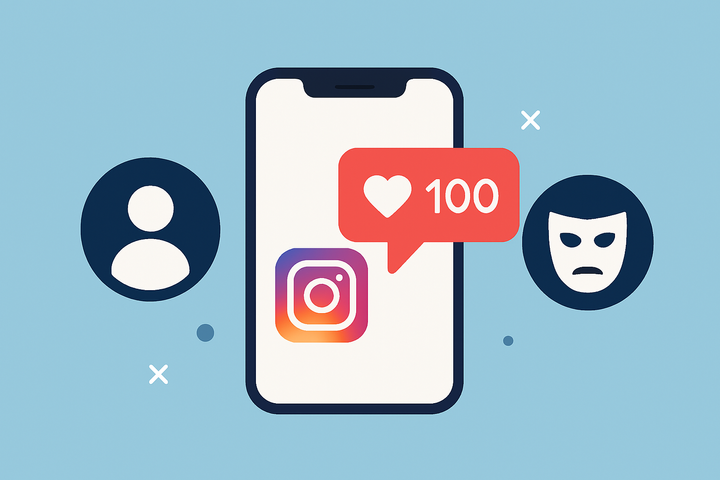How to Spot Fake Instagram Followers: A Creator’s Guide to Staying Authentic

Let’s be honest—growing on Instagram is hard. The algorithm changes, audience preferences shift, and organic reach isn’t what it used to be. That’s why many creators, especially when starting out, are tempted to “hack the system” with shortcuts like buying followers or using engagement pods. But here’s the thing: not all followers are created equal, and fake ones? They can do more harm than good.
If you're a creator trying to build a genuine community—or a brand looking to partner with influencers—learning how to spot fake Instagram followers is a skill you absolutely need.
Why Fake Followers Are a Problem (Even if Everyone’s Doing It)
It might seem harmless. “Just a few thousand fake followers to boost credibility—what’s the harm?”
Actually, there’s a lot of harm.
Fake followers don’t engage. They don’t comment, like, or share. They’re bots or inactive accounts that only inflate your numbers. So when Instagram sees that you have 50K followers but only get 200 likes per post, guess what? The algorithm thinks your content isn’t worth showing—and your reach suffers.
For brands, fake followers are an even bigger red flag. If you're pouring marketing dollars into influencer campaigns, you want real results from real people. Paying someone with a phony audience is like throwing money into the void.
What Are Fake Instagram Followers?
Before we learn how to spot fake Instagram followers, let’s understand what we’re dealing with.
Fake followers can be:
- Bots: Auto-generated profiles that follow accounts in bulk.
- Inactive accounts: Real people who’ve abandoned Instagram or barely use it.
- Purchased followers: Often a mix of bots and inactive users sold in bundles (e.g., “Buy 10K followers for $9.99!”).
Some are easy to spot. Others blend in, making it tricky—especially when you're evaluating another account.
1. Analyze Engagement Rate (The Real Metric That Matters)
Let’s say someone has 100K followers—but their posts barely crack 500 likes. 🚩 Big red flag.
A healthy engagement rate typically ranges from:
- 1.5% to 3% for mid-sized accounts
- 3% to 6% for smaller influencers
- 0.5% to 1% for mega-celebrities
You can calculate it manually: Engagement Rate (%) = (Likes + Comments) / Followers × 100
Tools like Influencer Marketing Hub’s Fake Follower Checker also help detect suspiciously low engagement rates automatically.
2. Check Follower Quality: Who's Actually Following Them?
You know how your gut just knows when something’s off? That’s a good thing to use here.
Go to their followers list and randomly tap a few profiles. Look for:
- No profile pictures
- Weird usernames (e.g., @user1234567890)
- Zero posts or followers
- Following thousands of accounts
If 3 out of 5 profiles look fake, that’s a pretty clear signal.
3. Watch for Sudden Follower Spikes
Growing a loyal audience takes time. No one gains 10,000 followers overnight—unless they went viral (or bought followers).
Use tools like Social Blade to track follower growth. Look for patterns like:
- 📈 Unexplained spikes followed by drops (Instagram often cleans up fake followers)
- 📉 Consistent high growth with low engagement
4. Look Out for Irrelevant or Spammy Comments
Ever see a post with comments like:
- “Nice pic 😍”
- “Check my profile!”
- “Follow 4 follow?”
These aren’t real engagement—they’re spammy or automated comments, often from fake followers or engagement pods.
5. Audit Content Quality and Consistency
Here’s a little human insight: real creators care about their content.
If someone has 50K followers but their posts are low-effort, unedited, or posted erratically (like once every few weeks), it’s worth questioning. Look for:
- High-quality images
- Clear storytelling
- Consistent branding and voice
You’re not judging perfection—just whether the content matches the audience size.
6. Ghost Followers vs. Fake Followers: What’s the Difference?
Good question.
Fake followers are typically bots or purchased followers.
Ghost followers are real people who follow you but don’t interact at all.
According to Bazaarvoice, ghost followers can still hurt your engagement rate. Cleaning them out might feel scary (“I’ll lose followers!”), but it’s better to have 5K engaged followers than 10K ghosts.
7. Red Flags When Collaborating With Influencers
If you’re a brand or agency reading this, here’s your checklist:
- ✔️ Ask for audience insights (from Instagram or third-party tools)
- ✔️ Request previous campaign metrics
- ✔️ Watch for inflated vanity metrics
- ✔️ Prioritize micro-influencers with genuine engagement
Don’t fall for big numbers—fall for real results.
8. How Fake Followers Hurt Your Instagram Growth
Let’s talk long-term.
Even if fake followers get you to a certain number faster, they sabotage your visibility. Instagram’s algorithm favors content that gets early engagement. If your fake followers scroll past without interacting, it tells Instagram: “This isn’t interesting.”
The result? Your content doesn’t reach even your real followers.
So even from a strategic standpoint, fake followers work against you.
9. What to Do If You Already Have Fake Followers
Hey, no judgment. Maybe you bought followers early on. Maybe they crept in naturally. It happens.
Here’s how to fix it:
- Go through your follower list and remove suspicious accounts manually
- Use tools like SpamGuard or Ghost Unfollowers to clean up
- Start focusing on authentic growth: Reels, carousels, niche hashtags, collaborations
- Engage genuinely with your audience in comments and DMs
Remember: Instagram is a long game. Play it smart.
Closing Thoughts: Authenticity Is the Real Flex
If you take away one thing from this blog, let it be this: numbers don’t define influence—trust does.
Whether you're a creator trying to grow or a brand trying to collaborate, learning how to spot fake Instagram followers is more than just due diligence. It’s about preserving the soul of social media—real connections, real stories, and real people behind the screen.
So next time you see someone with a million followers, don’t be blinded by the number. Ask yourself: Who’s actually listening?

